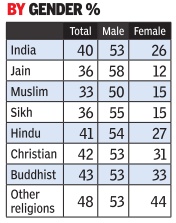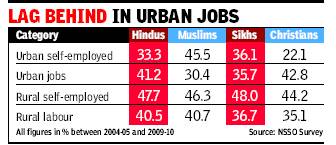Religion-wise demographics: India, after 2001
This is a collection of articles archived for the excellence of their content. |
Education
High school
2011: Muslims beat national average
The Times of India, Jun 10 2016
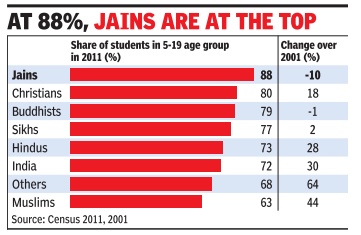
Subodh Varma
Student population rises 30%, Muslims beat national average
India's student population in the 5-19 age group has in creased by 30% between 2001 and 2011 but the rise is unevenly distributed among religious communities, with lagging sections playing catch up. Among Muslims, the number of students surged by 44%, and within that, girls recorded a staggering 53% rise. As a result, students now make up 63% of this age group among Muslims. This is still behind the 73% among Hindus, 80% in Christians and 88% in Jains -the highest student ratio in the 5-19 age bracket.
Details of student populations and employment among various religious communities are available in freshly released Census data.
In the 20-29 age group, the share of those seeking work was 20% nationwide. Among Christian youth, unemployment was strikingly higher at 26%. This is worrying because Christians were among the highest educated communities in the last Census, with 71% of those aged 5-19 studying.
Religious communities that had embraced education more widely in the past, like the Christians, Sikhs, and Jains, understandably show much smaller changes since the last Census in 2001. In fact, among Jains, there is a 10% decline in the number of students, a result of slow population growth, leading to fewer children in the studying age group though the student-population ratio is the highest. A significant increase is also seen in `other reli gious persuasions', which mainly comprise various tribal communities and faiths with fewer adherents like Parsis and Jews. The number of students increased by 64% for these communities as a whole.
Another feature of the changes in student populations is the high pace of growth of girl students. Barring Sikhs and Jains, the rate of increase is higher among girls in all communities. Among Hindus, the number of male students increased by 22%, compared to 36% for girls. Among Muslims, the corresponding figures were 37% and 53% and among `other religions', 48% and a phenomenal 86%.
All this points to the tremendous urge across faiths to attain education. Those with limited access to education earlier, whether as communities or as women across communities, are now embracing it. Hence, Muslims, tribals and women show the highest degree of change over a decade.
Just over 2% of students are working part-time as marginal workers. This proportion reaches nearly 4% for Christians and crosses 6% among `other religions'.
College (graduation)
2011: Jains, Christians top, Muslims improve
The Times of India, Sep 01 2016
Subodh Varma
Jains top in share of graduates
The Muslim community in India has the lo west share of graduates compared with others and just half the share of the countrywide average of under 6%. The Jains continue to be the most educationally advanced community with over a quarter of its members qualified as graduate or above. But, the share of technical diploma holders is highest among Christians at 2.2%, again continuing a previous trend, with the Jains at 1.1% and the Sikhs at 0.8%. A heartening feature is that the most educationally deprived communities like Muslims tionally deprived communities like Muslims and Buddhists are surging forward with shares increasing at a faster pace than other communities when compared to a decade earlier.These details emerge from the latest release of Census 2011data on educational levels across re ligious communities. The Census Office is still in the process of releasing such specific data over five years after the headcount took place. While illiteracy has de clined and educa tional levels at the primary or secondary level have rapidly increased across all communities, at the higher levels the dead weight of the past still casts a shadow. Those of college-going age were in primary school in the early to mid-nineties and enrolment in schools was still deficient especially among Muslims. This historic deprivation is reflected in the current lag in higher education participation levels.
But even the overall share of graduates continues to be abysmally low at 6% while the technical education level at just 0.6% is appalling. Most advanced countries have a graduate share of 30-50% accompanied by a high share of technical personnel also.
The changes between 2001 and 2011 Census show that the Muslim community has seen an almost 60% increase in share of graduates compared with about 55% for Hindus. But the most striking increase is among Buddhists mainly neoBuddhists who were Dalits that embraced Buddhism at the call of B R Ambedkar. The share of graduates among them has jumped by 74%. The country average is about 54% increase in the share of graduates.
The share of technical diploma holders too shows a similar change the most deprived communities are surging ahead, in relative terms. Thus, among Muslims, this share increased by 81% and among Buddhists by a jaw dropping 130% compared with a countrywide average of about 68%.
Employment, unemployment
The Times of India, Aug 26 2015
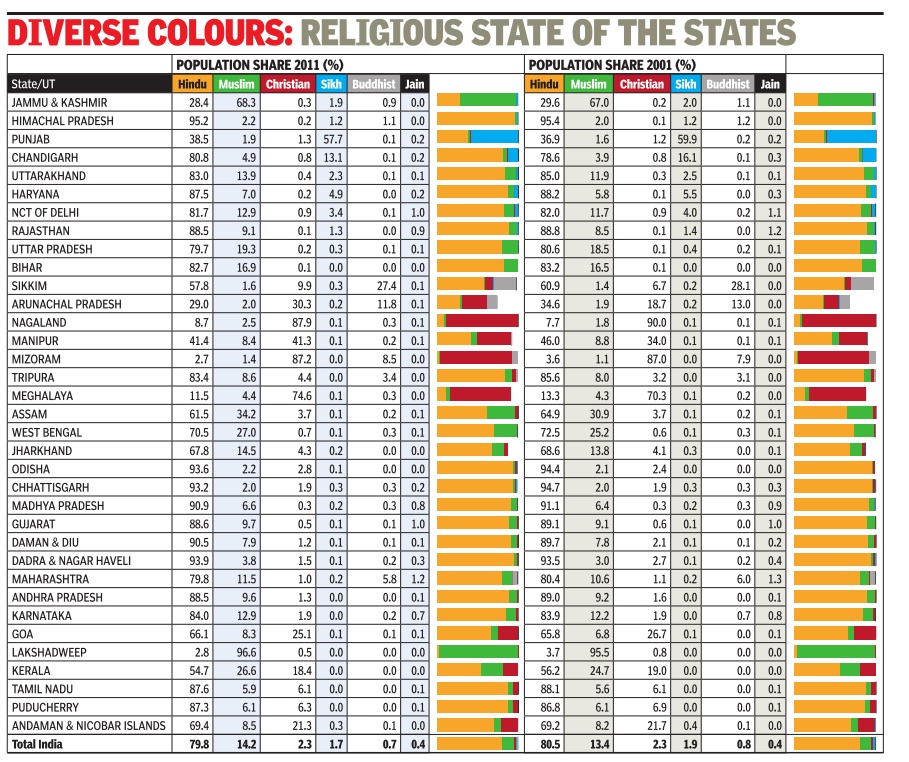
More religious minorities live in urban areas than rural
Subodh Varma Religious minorities in In dia -with the exception of Sikhs -live more in urban areas than rural. This trend existed in previous Census findings too but it appears to have outpaced the general trend of urbanization between 2001 and 2011, according to the Census 2011 data on religious communities released on Tuesday . While only 29% of Hindus live in urban areas, 40% of Muslims and Christians and a whopping 80% of Jains live in towns and cities. Over 43% of Buddhists, a large share of whom are converts from Dalit communities, live in urban areas. Sikhs, on the other hand, with extensive land holdings in Punjab are still largely a rural community , with only 28% of them living in urban areas. A mere 9% of other religious communities live in urban centers. Although details of smaller minority groups have not been released yet, Parsis are large Source: Census 2011, 2001 ly concentrated in urban areas of Maharashtra and Gujarat. Other communities in this category include communities with animist and other tribal beliefs, many of which live in remote areas in the Northeast. Over 77% of the country's Buddhists live in Maharashtra -the heartland of Dalit conversion to Buddhism at the call of Dr Bhimrao Ambedkar. Almost half of this population resides in urban areas.
Urban India's population inched up from 28% in 2001 to 31% in 2011. Urban Hindu population followed this trend, increasing from 26% to 29%. But Muslim urban population rose from 36% to 40% and Christian urban dwellers increased from 34% to 40%.
In some states, such as Gujarat, the jump in Muslim urban population is significantly higher than others -from 59% in 2001 to over 65% in 2011. This migration to towns and cities could be linked with the 2002 communal conflagration in the state and the desire for security .
In Maharashtra, urban share of the Muslim population continues to be high at 73%, up from 70% in 2001. In West Bengal, which has the largest Muslim population in any state, the share of Muslims staying in urban areas was 22% up from 17%.
In another high Muslim population state Assam, only 8% of the Muslims stayed in towns and cities, but that follows the low urbanization rate of just 14% in the state.
2001-11: `main workers' decline, `marginal workers' increase
The Times of India, June 8, 2016
Subodh Varma
Among all religious communities, the share of people working as `main workers', that is, those who worked for most part of the year, declined between 2001 and 2011 while the share of `marginal workers' those not getting work for more than six months a year increased. The share of people who were not working at all, mainly women, increased in all communities. The proportion of people in each religious community seeking or available for work, too, showed an uptick.It was marginal among Christians and Jains, and staggeringly high among `other' religious groups, mainly tribal communities.
These findings were recorded in 2011 by the census enumeration, and released on June 7, 2016. Although over five years have passed since this data on nature of work was collected, the Registrar General of India -as the census office is know -has released it only now. While 44% of the wor king age population were main workers and 14% marginal workers, a staggering 42% were `non-workers'.The vast bulk of these were women looking after domestic duties. This trend was reflected across various religious communities. Sikh and Jain communities had the lowest proportion of marginal workers but the highest share of non-workers. This is due to the lower participation of women in even marginal work, rendering them non-workers.
Interestingly , the census data includes numbers for those who were seeking or available for work among both the marginal workers as well as non-workers.
At the country level, the proportion of such work seekers had increased from 11% in 2001 to 15% in 2011.This trend was visible across all communities with share of work seekers among Muslims and Christians touching 16%.
Among tribal communities, primarily of central India and the northeast, main workers were much less than the national average while marginal workers are very high at 35% of the working age population. Non-workers' share is just 25% compared to the country-wide average of 42%, because women in these communities are heavily involved in work.But the most worrying indicator is that 28% of the working age people in these communities are seeking work.
2011-12: Unemployment, religion-wise
The Times of India, Feb 21 2016
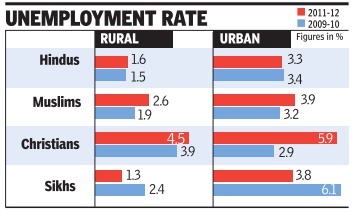
Mahendra Singh
Joblessness highest among Christians; Muslims next Joblessness is highest among Christians in comparison to other religious groups, reveals a government survey . The unemployment rate in the community stood at 4.5% in villages and 5.9% in cities and towns in 2011-12. Muslims come next with an unemployment rate of 3.9% in rural and 2.6% in urban areas.
Joblessness increased in villages across all religious communities, with the unemployment rate rising from 1.6% in 2004-05 to 1.7% in 2011-12, according to the National Sample Survey Organisation (NSSO).
Many view the high unemployment rate among Christians as a reflection of the higher education levels of community members who are in the job market. Christians have the highest percentage of graduates.
Though the unemployment rate in urban areas came down across all religions from 4.5% in 2004-05 to 3.4% in 2011-12, it remained higher than in rural areas.
Unemployment rates were lowest for Sikhs in villages (1.3%) and Hindus in urban areas (3.3%). The survey has raised serious questions re garding the former UPA government's policies for inclusiveness, with some analysts arguing that the measures failed to generate enough jobs in villages.
Majority of workers in rural areas were self-employed. The proportion of self-employment among males was the highest for Christians (56.6%); among females the share of self-employment was the highest among Sikhs (79%).
In rural areas, a significant proportion of workers (about 35%) -both males and females were engaged as casual labour. Among males, share of casual labour was the highest for Muslims (37.3%) and lowest among Christians (27.4%) while among females, share of casual labour was the highest among Hindus (36.6%) and lowest among Sikhs (14.8%).
Among rural males and females, proportion of regular wage or salaried employment was the highest for Christians (16.1% for males and 14% for females). In urban India, the share of self-employed and salaried employees were almost the same. In cities, highest selfemployment was among Muslims and Sikhs male (52.8%) and for females it was the highest for Muslims (61.3%).The proportion of salaried employment was highest for Christians (49.4%for males and 64.7% for females).
2009-10: Unemployment, spending
2009-10
Urban Sikhs face highest unemployment
Mahendra Singh TNN
The Times of India 2013/07/29
Unemployment was highest among Sikhs living in cities and towns during 2009-10 while the rate of joblessness showed a downward trend for Muslims in both urban and rural areas, a government survey released this month has revealed.
Muslims had the lowest per capita spending, according to the National Sample Survey Organization (NSSO), which in its 2009-10 survey put out a new report on employment trends for religious groups.
Unemployment among religious groups
Among communities, unemployment increased only among Sikhs living in urban India. The community saw unemployment rise from 4.6% in 2004-05 to 6.1% in 2009-10. However, among rural Sikhs, the rate declined sharply from 3.5% to 2.4% during the period.
The high unemployment rate among Sikhs in urban areas may be attributed to the fact that they are more educated and work with their hands and are vulnerable to economic slowdown which hit India in 2009-10, the period of survey.
In rural areas, unemployment was highest among Christians at 3.9%. However, it declined from 4.4% in 2004-05. The steepest decline in urban areas was witnessed among Christians, with the unemployment rate falling by 5.7 percentage points from 8.6% in 2004-05 to 2.9% in 2009-10.
Hindus had a stable unemployment rate at 1.5% in rural areas during the fiveyear period while all other communities in villages saw a decline. In urban India, the rate fell from 4.4% to 3.4% among Hindus.
Unemployment among Muslims in both rural and urban areas is falling. The rate declined from 2.3% in 2004-05 to1.9% in 2009-10 among Muslims living in villages. In cities and towns, the unemployment rate among Muslims fell from 4.1% to 3.2% during the five-year period. However, most Muslims in both rural and urban areas are self employed.
Spending/ consumption expenditure among religious groups
Per capita spending was highest for Sikhs, followed by Christians and Hindus.
At the all-India level, the average monthly per capita consumption expenditure (MPCE) of Sikh households was Rs 1659, followed by Christians (Rs 1543), Hindus (Rs 1125) and Muslims (Rs 980).
The survey found that self-employment was the mainstay for all religious groups in rural areas. The major source of earning from self-employment in agriculture was the highest among Sikhs (about 36%), but Muslims topped the chart in the category of rural workers.
In urban India, the proportion of households with major source of earning as self-employment was highest for Muslims (46%). The major source of earning from regular wage/salaries was the highest for Christian households (43%).
Most people irrespective of religious affiliation own between 0.1 and 1 hectare of land. About 43% of Christian households, 38% of Muslim and 37% of Hindu cultivated more than or equal to 0.001 hectare of land but less than 1 hectare. The proportion of households cultivating more than 4 hectares of land was the highest for Sikhs (6%), followed by Hindus (3%).
2011: Employment among religious groups
The Times of India Jan 04 2016
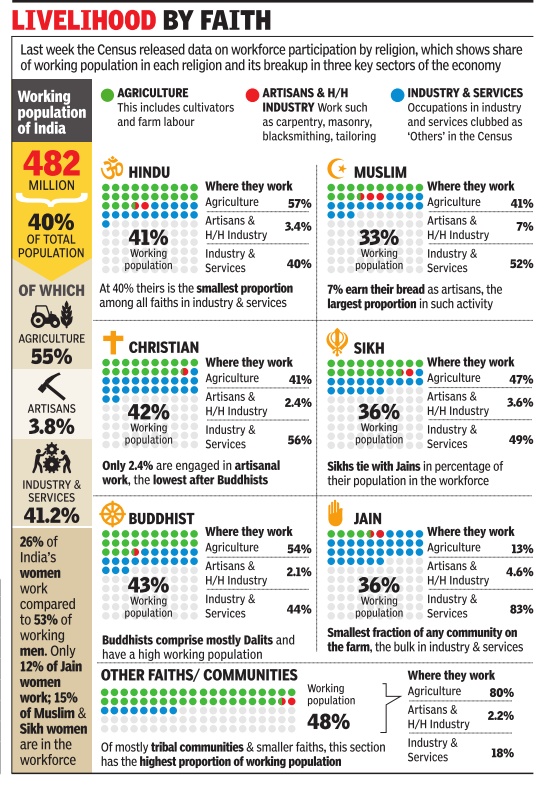
Subodh Varma
Buddhists Are Highest At 43%
Muslims have the lowest share of working people -about 33% -among all religious communities in India. This is lower than the nationwide average work participation rate of 40%.
The figure for Jains and Sikhs stands at 36% each. Buddhists, comprising mostly Dalits who embraced Buddhism in the 20th century , have a high working population share at 43%. For Hindus, the figure is 41%. Drawn from the Census 2011 data, the statistics show a faith-based profile of India's 482 million strong workforce.The figures haven't changed much from the 2001 Census, indicating a stasis in the economic status of communities.
The key reason behind low work participation rates in some communities seems to be the low work participation of women. Women's participation is just 15% for Muslims and Sikhs, and even lower at 12% among Jains. Among Hindus, there are 27% working women, while it is 31% for Christians and 33% for Buddhists. Several smaller faiths fall under `Other Religions'. These are mostly tribal communities from peninsular India and the northeastern states. Their work participation rates are markedly different from other communities. Nearly 48% of members of this section work, more than any of the country's six major religious communities. Women's work participation is also highest in tribal communities, at nearly 44%.
Census data also provides a picture of how many are engaged in what kind of work. For the country , 55% of workforce is in agriculture, as cultivators or as agricultural workers. The Census classifies all occupations in industry and services as `Other', a convention since British times. This makes up 41% of all workers.Only 13% of Jains are involved in agriculture, the lowest for any community .
While 41% of Muslims and Christians work in agriculture, this goes up to 47% among Sikhs and to 54% for Buddhists. The highest share of workers involved in agriculture is among Hindus, at 57%.
The Jain community is predominantly working in industry and services. Muslims too are largely concen trated in these sectors as are Christians. Muslims are also notably more involved in the `Household Industry' category which is mainly artisanal work like carpentry , black-smithing etc.
Among tribal communities classified under `Other Religions', over 80% of their members are working in agriculture, indicating their poor economic status.
Employment among Muslims
Number of jobless Muslims dips in both villages & cities
But Majority Still Outside Organized Sector
Mahendra Singh TNN
The Times of India 2013/08/19
New Delhi: Unemployment among Muslims is going down, marking an encouraging trend to gladden the champions of inclusive growth.
The unemployment rate for the community declined from 2.3% in 2004-05 to 1.9% in 2009-10 in rural areas and from 4.1% to 3.2% in urban areas. However, a vast majority of Muslims in both rural and urban areas are not part of the organized workforce compared to other religious groups.
In contrast, Hindus had a stable unemployment rate of 1.5% in rural areas during the five-year period while it fell from 4.4% to 3.4% in urban India.
According to data released by the National Sample Survey Organization, Muslims are mainly engaged in self-employment and as rural labour.
In cities and towns, Muslims are at the bottom of the ladder in the ‘regular wage/ salaried’ category. Among the major religious groups, only 30.4% of Muslim households are in regular jobs, followed by Sikhs (35.7%), Hindus (41%) and Christians (43%). In contrast, the proportion of households with major source of earning as self-employment was the highest for Muslims (46%) in urban areas.
In villages, Muslims (41%) are the largest group employed as rural labour with another 46.3% in the self-employed category. Majority of households of all religious groups, other than Muslims, belong to the self-employed in agriculture category, the survey found.
In rural areas, the proportion of households depending on self-employment was the highest among Sikhs (48%). The community’s major source of earning is self-employment in agriculture (around 36%), followed by Hindus (33%) and Christians (30%).
Intake of Muslims in central government organizations has increased by more than 3 percentage points in six years, from 6.93% in 2006-07 to 10.18% in 2010-11. This coincides with directives by the Centre to ministries and departments that they should take special measures to boost minority presence in jobs. That more Muslims are joining paramilitary forces and railways could start a robust trend. Increasing presence in the police would also strengthen their confidence in security matters.
Muslim share in govt jobs moving upwards
Subodh Ghildiyal TNN
The Times of India 2013/08/19
New Delhi: The intake of Muslims in central government bodies has increased by over 3 percentage points in six years, reflecting a visible improvement in the community’s share of public sector jobs that the UPA marked out as priority after coming to power in 2004.
Government figures show that the recruitment of minorities in central government organizations stood at 10.18% in 2010-11, up from 6.93% in 2006-07.
The increase of three percentage points in employment across sectors in the last six years coincides with the directives that the Centre issued to ministries and departments that they should take special measures — publicity campaigns about recruitment drives and inclusion of minority members in interview panels — to boost minority presence in jobs.
Minority has been a thinly-disguised term for Muslims who form an overwhelming share of religious minorities. Social activist and former National Advisory Council member Harsh Mander dubbed the increase as significant and credited the community for the success.
“It is the outcome of efforts on the part of community members to break out of restraints on social mobility they have been traditionally bound by,” he said, adding the government contribution in the trend was smaller.
The percentage of minorities in total hiring across central government jobs was 6.93% in 2006-07. It went up to 8.23%, 9.90%, 7.28% and 10.18% in the following years. Sensing inconsistency, the ministry has called for review of the 2011-12 figures that stand at a dismal 6.24%.
The significance of increasing number of Muslims in central recruitment extends beyond mere job share.
That they are joining paramilitary forces and railways, the largest public sector employers, in greater numbers could start a robust trend for future. The community’s increasing share in the police force would also strengthen their confidence in security matters.
‘Muslims lag in per capita spend’
Around 25% of Muslims are engaged in self-employment in non-agricultural sector, followed by Christians (14.7%), Hindus (14.5%) and Sikhs (12.4%), according to the NSSO data.
The poor state of affairs among Muslims is also reflected in low per capita spending compared to other religious groups. The household monthly per capita consumer expenditure (MPCE), which serves as a proxy for income and is usually taken to reflect the living standard of a family, was lowest among Muslims. Muslim households were spending Rs 980 (Rs 1,272 in urban areas and Rs 833 in rural areas).
The average MPCE (for both urban and rural) was the highest for Sikh households, followed by Christians and Hindus. The average MPCE of a Sikh household was Rs 1,659 (Rs 2,180 in urban areas and Rs 1,498 in rural areas).
Fertility rate, religion-wise
2015-16: below replacement level for all but Hindus, Muslims
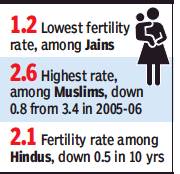
From: Rema Nagarajan, Fertility rate below replacement level for all but Hindus & Muslims, January 12, 2018: The Times of India
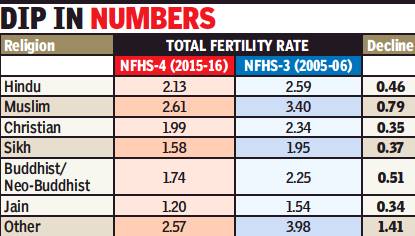
From: Rema Nagarajan, Fertility rate below replacement level for all but Hindus & Muslims, January 12, 2018: The Times of India
The average number of children born to a woman over her lifetime, or total fertility rate (TFR), has dropped below replacement for all religious communities barring Hindus and Muslims. The fertility rate of Hindu households fell from 2.8 in the last survey in 2004-05 to 2.1, the level at which a population is said to be able to replace itself from generation to generation without migration. The fertility rate of Muslim households fell from 3.4 to 2.6. This was revealed in the latest religion-wise data from the National Family Health Survey (NFHS) of 2015-16.
The community with the lowest fertility rate, 1.2, was the one with the highest level of education, the Jains. This was followed by Sikhs (1.6), Buddhists or Neo Buddhists (1.7) and Christians (2). India’s overall TFR was 2.2.
‘Lowest income section has most kids’
Predictably, when looking at the fertility rate of the different wealth quintiles (onefifths of the population), the section with the lowest income had the highest number of children at 3.2 and the richest had the least, 1.5. Scheduled tribes, the least developed among social categories, had the highest fertility rate of 2.5, followed by 2.3 for scheduled castes and 2.2 for other backward classes. The upper castes had the lowest fertility rate of 1.9.
The younger the women, the lower the mean number of children born to them, evidence of the progress over the last two decades in bringing down the total fertility rate. The TFR for Muslim women aged 40-49 was the highest at 4.2 and it was the lowest for Jain women of the same age at 2.2. Hindu women of this age group had the second highest TFR of 3.1.
The median age at first birth among women aged 25-49 years was lowest for Muslim and Hindu women, 21.3 years and 21.6 years respectively.
It was highest among Sikhs at 23.8 years. Among the different wealth quintiles, the median age at first birth was lowest among the poorest women at 20.3, steadily rising with rising affluence to touch 24.4 years among women in the richest one-fifth of the population.
The survey showed that almost 30% women with one child had got sterilised, suggesting that they had decided they did not want any more. Almost 84% of women with two children had got sterilised. This was the case for 77% of the poorest women who had two children and almost 89% of women in the highest wealth quintile with two kids.
State main determinant of fertility; religion comes next
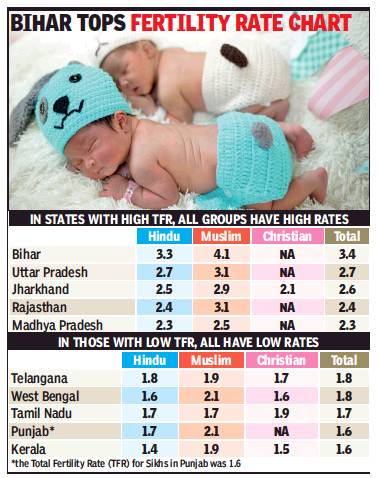
From: Rema Nagarajan, State key to fertility rates, not religion: Govt data, January 19, 2018: The Times of India
See graphic:
The states with the highest and lowest fertility rates in 2015-16
Cultural and geographical factors, and the level of development of different states seem to be more important determinants of how many children a woman has than her religion. The latest state-wise data of the National Family Health Survey (NFHS) 2015-16 shows that the total fertility rate (TFR) of different religious communities shows greater variation between states than between communities.
For instance, though the all-India TFR — defined as the number of children likely to be born to a woman over her lifetime — is 2.6 for Muslims, compared to 2.1 for Hindus and 2 for Christians, the rate for Muslims varies widely from 1.7 in Tamil Nadu to 4.1in Bihar, the state with India’s highest fertility rate. Similarly, the Hindu TFR ranges from 1.4 in Kerala to 3.3 in Bihar.
In fact, in Chhattisgarh, the Muslim TFR of 2.1 was lower than the 2.2 for Hindus, and in Odisha Muslims had the lowest TFR among the three sizeable religious groups — Hindus, Christians and Muslims.
While the Christian TFR was lower than for Hindus or Muslims at the nationwide level, in several northeastern states Christians had significantly higher fertility rates than Hindus.
One result of this kind of wide variation between states is that even Hindus and Muslims have fertility rates at or below replacement levels in several states. In case of Muslims, there are 10 such states. All but one of these states had a TFR well below replacement level. In case of Hindus, 18 states had overall TFRs at or below the replacement rate.
Interestingly, though Christians’ country-level TFR of 1.99 is well below replacement level, it was clearly above replacement level in most northeastern states and Chhattisgarh, which are all states with above-replacement level fertility rates.
Growth rate (religion-wise) and other demographics, 2011
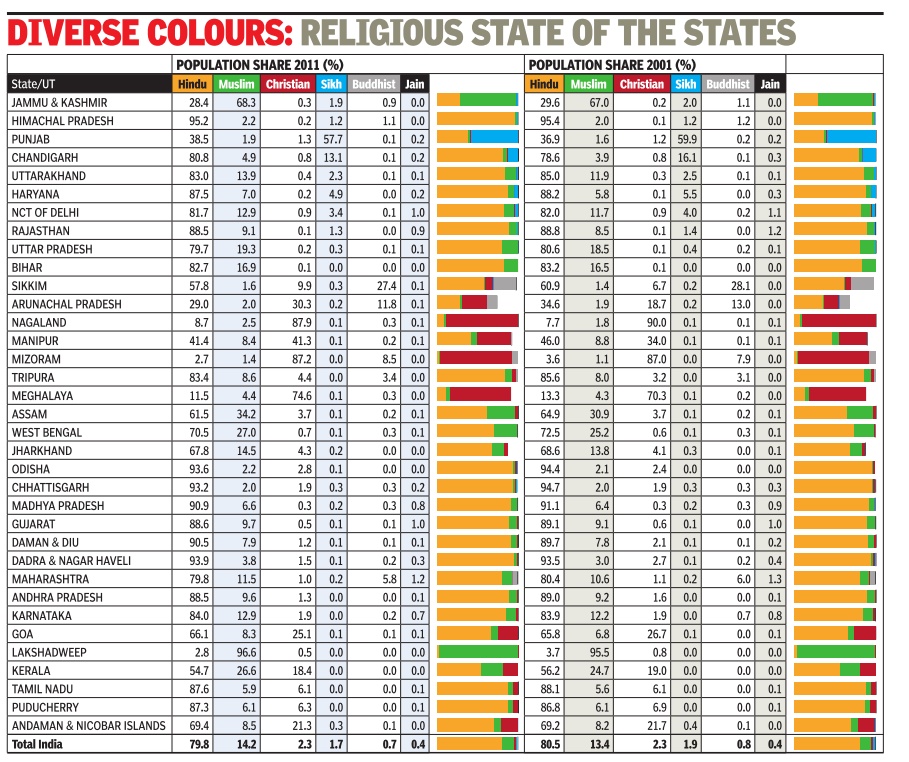
The Times of India, Aug 26 2015
Bharti Jain
In 10 Yrs, Muslims Grew By 24.6%, Hindus 16.8%
The Muslim population grew by 24.6% between 2001 and the 2011 Census, against the 16.8% decadal growth rate of Hindus in the same period. Though the all-India decadal growth of Muslims was less than 29.3% between 1991 and 2001, their statewise decadal growth rate, as reflected in the 2011 Census, is higher than Hindus in all 35 states and UTs.
The 2001-11 growth rate of total population was 17.7%.Christians, during this period, grew by 15.5%, Sikhs by 8.4%, Jains by 5.4% and Buddhists by 6.1%. Those stating other religions and persuasions grew by 19.6% in the 10 years preceding 2011.
Significantly, the number who didn't state their religion went up by 294% between 2001 and 2011.
The stateUT figures for decadal growth between 2001 and 2011 show a notable rise in the Hindu population of UP (24.6%), Jharkhand (21.1%), Rajasthan (20.9%), MP (20%), Puducherry (28.9%) and NCT of Delhi (20.7%). States that show a Hindu decadal growth less than the national average are Kerala (2.2%), Arunachal (5.8%), Bengal (10.8%), Assam (10.9%), Andhra (10.3%), Himachal (12.6%), Odisha (13.2%), Chhattisgarh (13.2%), TN (14.9%), Maharasthra (15.2%), Karnataka (15.8%) and Haryana (16%), among others. Lakshadweep and Mizoram recorded a negative decadal growth at -19.5% and -4.5%. This could be due to their low population base.
States and UTs where the Hindu decadal growth was higher than their averages are Punjab, Karnataka, Goa, Puducherry , Chandigarh, Nagaland, Daman & Diu and Dadra & Nagar Haveli.
Muslims, on the other hand, rose across states, bet tering their national average in Mizoram (46.9%), Haryana (45.7%), Chandigarh (44.7%), Punjab (40.2%), Nagaland (39.9%), Uttarakhand (39%) and the NCT of Delhi (33%), Rajasthan (29.8%), Assam (29.6%), Bihar (28%) and Gujarat (27.3%). Kerala returned interesting results with a 12.8% rise in Muslim population between 2001 and 2011, far higher than the corresponding figures for Hindus (2.2%) and Christians (1.4%).
The decadal growth rate for Christians (2001-11) was higher than 100% in Bihar and Arunachal, but the community recorded a negative growth in five states, including Nagaland (-2.8%), Andhra (-4.4%), Lakshadweep, Daman & Diu and Dadra & Nagar Haveli.
Sikhs recorded a high decadal growth in Odisha (25.7%), Gujarat (27.8%), Andhra (29.8%), Kerala (38.1%) and TN (53%), among others. The community showed negative growth in eight statesUTs.
Jains have shown a 5.4% decadal growth across the country . While Himachal shows a notable growth rate for the community between 2001 and 2011 (28.2%), as many as 8 states recorded a negative growth rate.
Religion-wise distribution of population
India, as a whole
August 26, 2015: The Business Standard
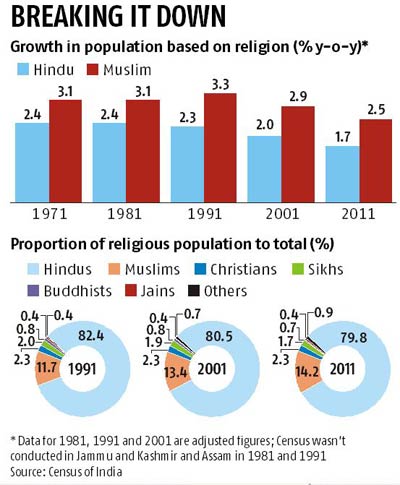
Proportion of religios population to total (%)
From:August 26, 2015: The Business Standard
The growth rate of the Muslim population has consistently declined or remained constant since 1971 till 2011, with the only exception being the 10-year period ended 1991. Experts believe the population growth will fall further with rising education levels among Muslims.
However, the proportion of Muslims to the total population of India rose over the decades, while that of Hindus declined, showed the Census data released on Tuesday.
India's total population stood at 1.21 billion in 2011. Of this, Hindus constituted less than 80 per cent for the first time in 2011. Their proportion to total population fell to 79.8 per cent in 2011, against 80.5 per cent in 2001 and 82.4 per cent in 1991.
On the other hand, the proportion of Muslims in the total population rose to 14.2 per cent in 2011 from 13.4 per cent in a decade before and 11.7 per cent in 1991.
The proportion of Christians in the country's population remained constant at 2.3 per cent in all these years.
In absolute terms, there were 966.3 million Hindus in 2011, while there were 172.2 million Muslims, 27.8 million Christians, 20.8 million Sikhs (1.7 per cent of the country's total population), 8.4 million Buddhist (0.7 per cent), and 4.5 million Jains (0.4 per cent).
The population of Muslims rose at the rate of 2.5 per cent a year between 2001 and 2011, which is a 0.4 percentage points lower than 2.9 per cent witnessed during 1991-2001. On the other hand, the population of Hindus grew 1.5 per cent a year during 2001-11, which is 0.3 percentage points lower than two per cent in the previous decade. While the population of Muslims grew faster than Hindus during 2001-2011, in the previous decade, the pace of growth declined faster than that in the former than the latter.
The rate of growth in the Muslims population declined 0.4 percentage points between 1991 and 2001 over that between 1981 and 1991. The rate of growth in Hindu population declined by 0.3 percentage points over this period. In fact, the growth rate of Muslims population never rose except in 1981-91 period. It remained constant in the 1971-1981 period.
According to sociologists, the dip in the growth rate of Muslim population over the decades was the result of elementary education among them. "The impact of primary education on fertility decline is quite high in Muslims. The whole fear that Muslim populations will overtake Hindu population is nonsense. This is because fertility decline is taking place due to the impact of primary education," said Amitabh Kundu, senior fellow at Delhi Policy Group.
Why, then, was the rate of growth in Muslims at 2.5 per cent was still higher than Hindus at 1.7 per cent in 2011? "A large proportion of Muslim women are still not literate, which explains this trend. With inclusive growth, education level will go up and fertility level will drastically go down over the years," says Kundu.
The release of the Census data by the National Democratic Alliance assumes significance as it was supposed to be out early last year, but was delayed. There were allegations that the previous United Progressive Alliance government did not release the data as elections were round the corner.
2011, least religious cities
See graphic:
10 least religious districts in India, 2011
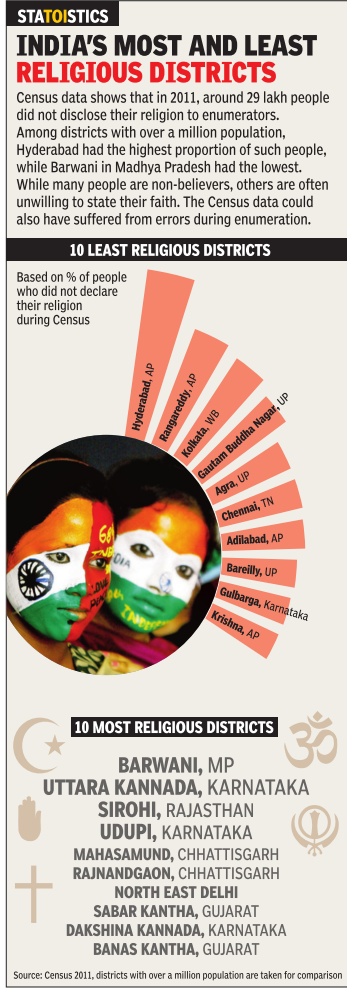
Rajasthan: 2011
The Times of India, Sep 10, 2016
Shoeb Khan
Rajasthan has one Jew, 85 Parsis
The state has just one registered Jew and about 85 Parsis among its population of 6.85 crore, as per the Census report on other religions released.
Parsis, who set foot in this region during the British era over a century ago, are on the verge of `extinction' in the state. Both these ethnic minority have their roots in Ajmer, Merwara, which was directly under the colonial rule.
In a surprise, Rajasthan also has 50 persons who identified themselves as members of Natural Religion (religion of nature), which follows Native American traditions.
However, none of them could be traced. Pushkar in Ajmer has a rich history of Jews which goes back to the period before the founding of Israel (1948). Over the past few decades, the number of Jews outnumbers other foreign tourists in Pushkar. It's also home to one of the nine Chabads (religious centre of Jews) in the county , where Jewish festivals are still celebrated.
The Jewish population is barely above 500 in the country. Parsis, known for their business acumen, came to Ajmer to establish the railways from Gujarat and Bombay . They numbered 300 during the period between 1870 and 1890. With the Parsi population fast declining in the country , their numbers have dwindled to 85 in 2011.
Adarbad Motafram, a lone priest living in Ajmer and a caretaker of the fire temple, says, "Barely 20-21families from my community are left in Rajasthan. Ajmer has nine families, Udaipur five, Jaipur three, Jodhpur and Kota one each.We gather during our festivals, with Nowruz the most popular." Motafram is a geography professor at the Government College of Ajmer. Buddhism, which had flourished in Hadoti region, has only about 12,000 followers in the state now. The Buddhist monasteries or complexes at four places -Bhairat in Alwar, Kholvi in Jhalawar, Bandarez in Dausa and Ramgoan in Tonk -testifies to the strong presence of Budhism in this region, which has disappeared with time.
Discovered by the Archaeological Survey of India's (ASI) first director-general Alexander Cunningham in the late 18th century , these historical sites are today crying for attention from the state. Baha'i, considered one of the most persecuted religions, also has its presence in Rajasthan, in Jaipur. They often hit the headlines for being persecuted in Iran and Turkey . Figures say that the state has 18 Baha'is. They also have a religious centre in Sanganer which faced attacks in 2015 over the ownership of property . Most of their religious practices are identical to Islam, and names similar to Muslim names. Baha'i religious leaders claimed they have followers numbering to about 20,000 in the state."Due to persecution, we identify ourselves as Muslims," said a Baha'i leader, requesting anonymity .
Religion, adherence to
The Times of India, Aug 27 2015
Sivakumar B
2.87 million Indians have no faith, census reveals
India has 2.87 mil ion people who have no aith in any religion -0.24% of the country's population of 1.21 billion -according o the 2011 census, which was the first to include a `non aith' category . The figure includes atheists, rationalists as well as those not interested n any religion but believe in some `unknown' force. A majority of people 1,643,640) who ticked the non aith category live in rural areas as compared to those in urban areas (1,223,663). More males (1,463,712) than females 1,403,591) said that they did not believe in any faith.
Uttar Pradesh accounts or the most people registered as `non-faith' (582,000) than any other state. Bihar, Bengal, Andhra Pradesh, Telangana, Karnataka and Tamil Nadu all have more than one akh people in the category .
TN, perhaps more than any other state, has a history of atheism. It started with E V Ramasamy (1879-1973), popularly known as Periyar, who propagated atheism (or rationalism) in the early 1900s. Since then, the political party he founded, Dravidar Kazhagam, and members of its offshoots, the Dravidian parties like DMK, have had avowed atheists.Over time, though, some of the non-believers found religion and perform yagas that Periyar had fought against tooth and nail.
“It is welcome that our voice has been recorded for the first time in the census,“ Dravida Kazhagam leader K Veeramani said. But he believes there are many more non-believers than the census department recorded.
“There are two parts to this,“ he said. “One is that the census department does not have a foolproof system of collecting data. Two, there are some non-believers who don't have the courage to say they don't belong to any religion. If you include them I'm sure the non-faith category would comprise at least 1% of the population.“
A 2012 WIN-Gallup poll would appear to corroborate that view: the report, based on interviews with 50,000 people from 57 countries, stated that 3% of Indians were convinced atheists and 3% were unsure or did not respond. It said 81% of Indians were religious and 13% were not religious.
Andhra Pradesh too has had several non-believers.The Atheist Centre based in Vijayawada and its founder Gora (Goparaju Ramachandra Rao) and his wife Saraswathi Gora fought against superstitions both during the freedom movement and after Independence.
Indians who do not state their faith
The Times of India, Aug 31 2015
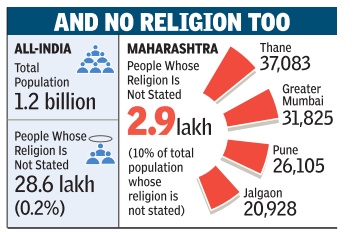
Anahita Mukherji
29 lakh Indians refuse to state faith
Is it fear of persecution or are people giving up on religion?
All through her daughter's growing years, economist Vibhuti Patel would write `humanism' in the column meant for religion in school forms. She would routinely be called out during open house to explain precisely what that term meant. “I'm Hindu. My husband is Muslim. Neither of us is religious, and humanity is our driving force,“ says Patel. Little wonder then, that when census officers come knocking at her door, she and her family do not fill in the column for religion. They are among 28.6 lakh people (or 0.2% of India's population) whose religion has not been recorded in Census 2011. “A growing number of people strongly object to revealing caste or religion as they do not believe in either,“ says Patel, who heads the economics department at SNDT Women's University in Mumbai.
Nearly 10% of people whose religion has not been mentioned in the census are from Maharashtra.
“Maharashtra is one of India's most industrialised areas, so it has witnessed a large amount of in-migration. Because the labour market here is so segmented, with employers showing a preference for people from a certain religion or caste, many do not reveal their religion for fear of losing their jobs,“ points out Patel.
She adds that street children, many of whom are very bright, refuse to reveal personal details of their past when enrolled in school as they are afraid of being reunited with the family they ran away from. The religion they once belonged to is a detail they are often reluctant to divulge.
Institutionalised untouchability is also a factor that prevents people from revealing their caste and religion. “The highest proportion of Dalits in the country is from Maharashtra,“ adds Patel. Given the huge role played by religion in Indian life, sociologist Nandini Sardesai finds it incredibly interesting that a sizeable proportion of people is choosing not to record religion. She feels this may have much to do with a growing breed of youth who want to assert the fact that they do not need to ascribe to the faith they were born into.While Sardesai is not religious, she usually states the religion she was born into when it comes to filling out forms. “I'm impressed that many young people are a step ahead of me,“ says Sardesai, who believes that the phenomenon indicates an undercurrent of rationality and secular cosmopolitanism.
See also
Religion-wise demographics: India, 1765-1805
Religion-wise demographics: India, 1837-1857
Religion-wise demographics: India, 1909
Religion-wise demographics: Muslim population in India, 1909
Religion-wise demographics: India, after 2001

